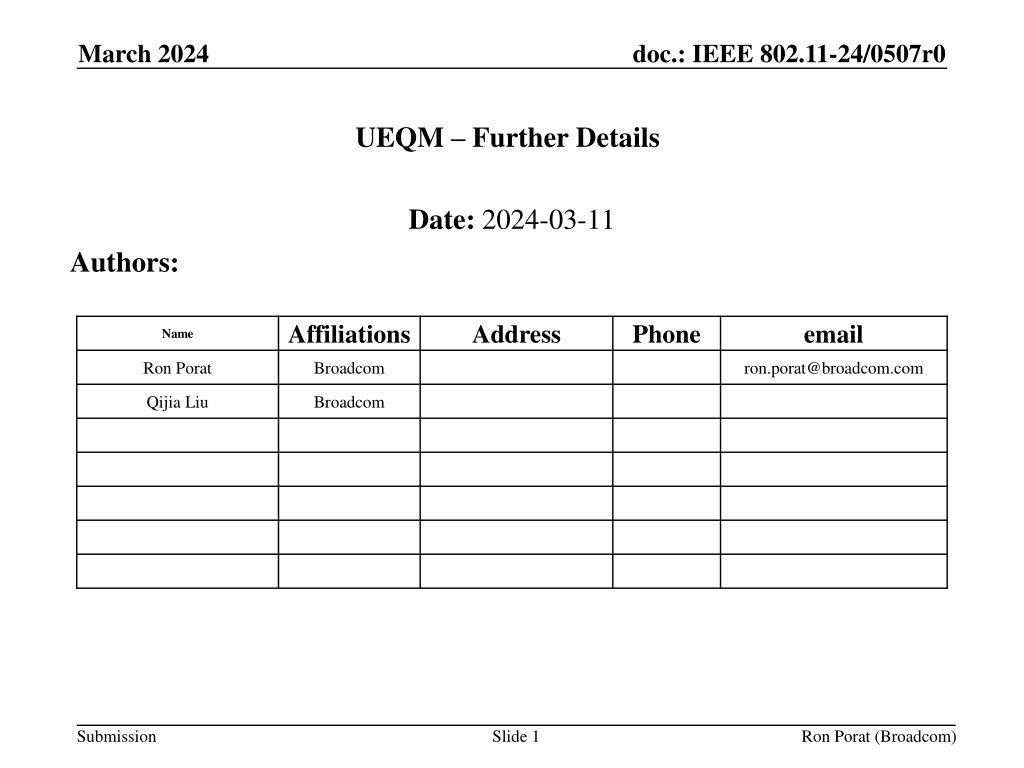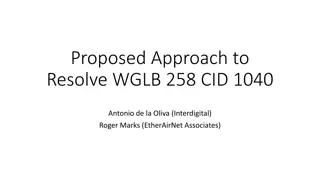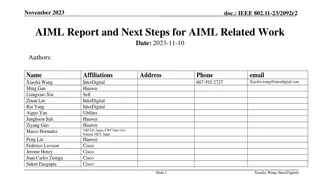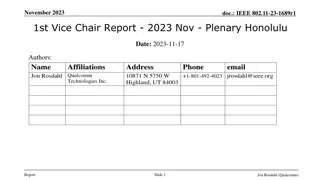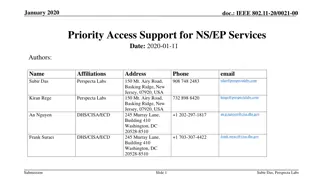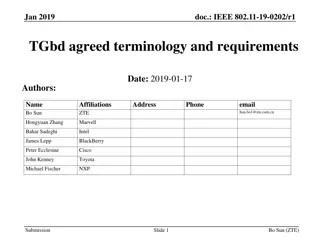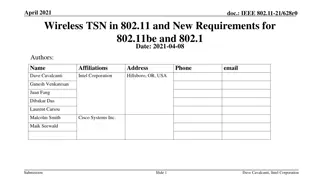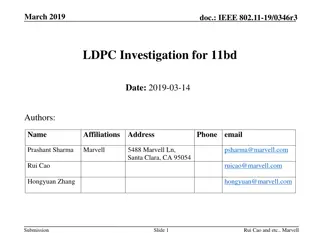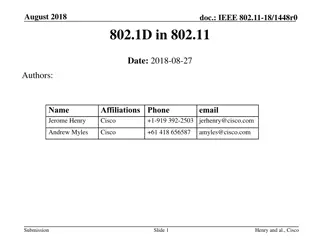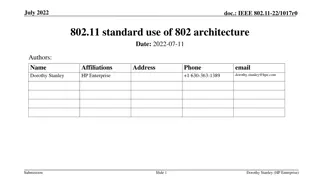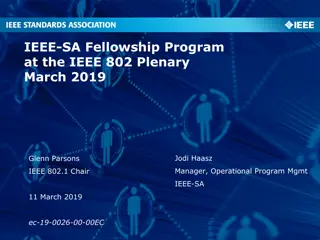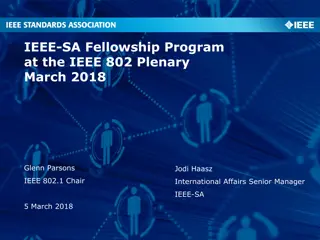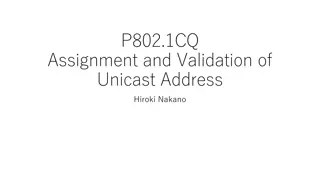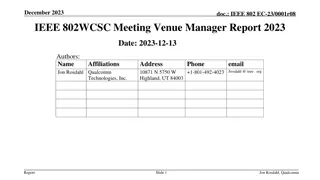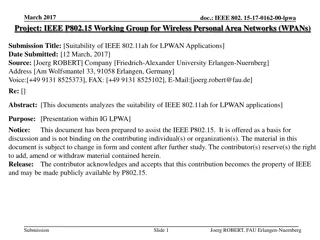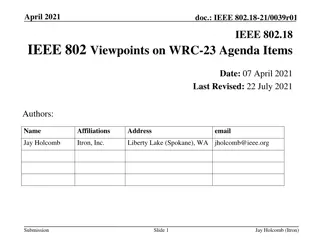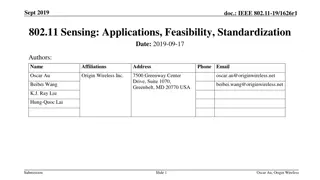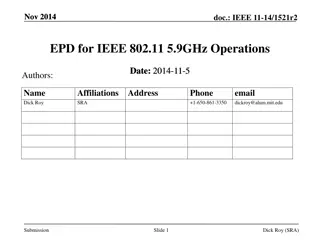UEQM Implementation Strategies in IEEE 802.11-24
This document delves into the optimal combinations of UEQM for various spatial streams in IEEE 802.11-24, focusing on maximizing gains while simplifying implementation challenges. The presentation addresses considerations like QAM differences, number of supported combinations, and performance metrics derived from simulation assumptions and discussions on achieving full potential gains with limited complexity.
Download Presentation

Please find below an Image/Link to download the presentation.
The content on the website is provided AS IS for your information and personal use only. It may not be sold, licensed, or shared on other websites without obtaining consent from the author.If you encounter any issues during the download, it is possible that the publisher has removed the file from their server.
You are allowed to download the files provided on this website for personal or commercial use, subject to the condition that they are used lawfully. All files are the property of their respective owners.
The content on the website is provided AS IS for your information and personal use only. It may not be sold, licensed, or shared on other websites without obtaining consent from the author.
E N D
Presentation Transcript
March 2024 doc.: IEEE 802.11-24/0507r0 UEQM Further Details Date: 2024-03-11 Authors: Affiliations Address Phone email Name Ron Porat Broadcom ron.porat@broadcom.com Qijia Liu Broadcom Submission Slide 1 Ron Porat (Broadcom)
March 2024 doc.: IEEE 802.11-24/0507r0 Introduction [1]-[4] introduced the topic of UEQM UEQM provides gain but the number of combinations is potentially very large which complicates implementation and link adaptation. Our goal in this presentation is to find the sweet spot between the number of combinations and performance. We focus on two aspects: What should be the maximum QAM difference between the strongest and weakest streams How many UEQM combinations should we support We further focus on 2 and 3 spatial streams Submission Slide 2 Ron Porat (Broadcom)
March 2024 doc.: IEEE 802.11-24/0507r0 Simulation Assumptions SVD based Tx beamforming MIMO Configs: 2x2, 3x3, 4x4 80MHz DNLOS, BLOS, 500 channel realizations for each MIMO config MCS0-13 on all streams Including RF impairments Gain numbers based on RvR simulation, which uses genie rate selection per channel realization at each SNR point Submission Slide 3 Ron Porat (Broadcom)
March 2024 doc.: IEEE 802.11-24/0507r0 Optimal UEQM combinations for Nss=2 80MHz 2x2 DNLOS TXBF Mod[stream] 0 x x x x x combinations all diff-2 1 x diff-1 0 1 2 3 4 x-1 x-2 x-3 x-4 80MHz 2x2 BLOS TXBF Up to QAM diff-2 recommended in order to achieve full potential gains with limited complexity Submission Slide 4 Ron Porat (Broadcom)
March 2024 doc.: IEEE 802.11-24/0507r0 Optimal UEQM combinations for Nss=3 in 4x4 80MHz DNLOS 4x4 Nss=3 TXBF # UEQM combinations 1 2 Mod[stream] 0 x 1 x 2 x 3 0 1 2 3 4 5 x x x x x x x-1 x-1 x-1 x x-1 x-2 x-2 x-2 x-2 80MHz BLOS 4x4 Nss=3 TXBF # UEQM combinations 1 2 Mod[stream] 0 x 1 x 2 x 3 0 1 2 3 4 5 x x x x x x x-1 x-1 x-1 x x-1 x-2 x-2 x-2 - x-2 Submission Slide 5 Ron Porat (Broadcom)
March 2024 doc.: IEEE 802.11-24/0507r0 Discussion Metric for best Nss=3 UEQM combination subsets: max average goodput gain percentage in SNR [20,30]dB (see Appendix for switching point between Nss=3 and Nss=4) Compared with all combinations (UEQM with QAM diff-3 and 4), limiting to QAM diff-2 is close to optimal. Selecting only l or 2 UEQM combinations results in sub-optimal performance. Out of the 5 possible diff-2 combinations for Nss=3, combinations (1,3,4) or (1,2,4) provide good performance. Submission Slide 6 Ron Porat (Broadcom)
March 2024 doc.: IEEE 802.11-24/0507r0 Optimal UEQM combinations for Nss=3 in 3x3 80MHz DNLOS 3x3 Nss=3 TXBF # UEQM combinations 1 2 Mod[stream] 0 x 1 x 2 x 3 0 1 2 3 4 5 x x x x x x x-1 x-1 x-1 x x-1 x-2 x-2 x-2 x-2 80MHz BLOS 3x3 Nss=3 TXBF # UEQM combinations 1 2 Mod[stream] 0 x 1 x 2 x 3 0 1 2 3 4 5 x x x x x x x-1 x-1 x-1 x x-1 x-2 x-2 x-2 x-2 Submission Slide 7 Ron Porat (Broadcom)
March 2024 doc.: IEEE 802.11-24/0507r0 Discussion Extended Nss=3 SNR range in 3x3: max average goodput gain percentage in SNR [15,50]dB In summary combination (1,3,4) is the best for Nss=3, considering 3x3 and 4x4 Submission Slide 8 Ron Porat (Broadcom)
March 2024 doc.: IEEE 802.11-24/0507r0 Conclusions It is possible to achieve almost all the gains of UEQM with up to 3 combinations and with a limitation to a difference of up to 2 levels of QAM between the strongest and weakest streams Recommend that 11bn adopts the following options for UEQM: Nss=2 Nss=3 Submission Slide 9 Ron Porat (Broadcom)
March 2024 doc.: IEEE 802.11-24/0507r0 References [1] 11-24-0117-01 Improved Tx Beamforming with UEQM [2] 11-24-0016-01-00bn-uhr-mimo-rvr-enhancement-with-unequal-modulation [3] 11-24-0113-01-00bn-unequal-modulation-in-mimo-txbf-in-11bn [4] 11-24-0176-01-00bn-unequal-modulation-over-spatial-streams Submission Slide 10 Ron Porat (Broadcom)
March 2024 doc.: IEEE 802.11-24/0507r0 SP #1 Do you agree to add to the 11bn SFD : UEQM is limited to the following combinations: Nss=2 Nss=3 Submission Slide 11 Ron Porat (Broadcom)
March 2024 doc.: IEEE 802.11-24/0507r0 Appendix - Nss=3 and Nss=4 Link Adaptation To help decide the SNR range for Nss=3, we show the Nss=3 to Nss=4 transition SNRs with 4x4 antenna configs and TXBF Nss=4 transition SNR (dB) DNLOS 34 26 BLOS 41 33 EQM UEQM 80MHz DNLOS 4x4 Nss=4 TXBF 80MHz BLOS 4x4 Nss=4 TXBF Submission Slide 12 Ron Porat (Broadcom)
